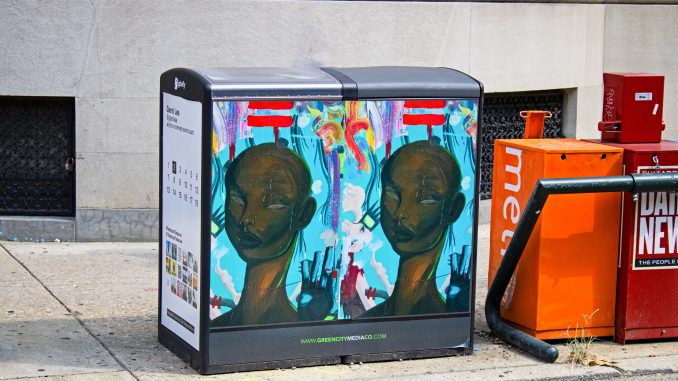
Northeast Philadelphia car dealership Barbera Autoland covered 375 Center City trash cans this summer with advertisements reading, “Barbera on the Boulevard has 300 Jeeps cheap!”
Conrad Benner, the founder and editor of streetsdept.com, a blog documenting Philadelphia’s street art, wondered how this happened.
“Who are the public officials who are in charge of the public space [and] are allowing it to be sold for this purpose?” he said.
Eighteen local artists, including several university alumni, took over the trash cans this summer, replacing the dealership’s ads with artwork like paintings, photographs and digital art. The art went up on Aug. 19 and will be displayed until Sept. 18.
Benner first called attention to the advertisements on his blog in June, when he wrote he couldn’t be the only person upset by the advertising in public spaces. As it turns out, he wasn’t.
Brendan Lowry, a 2011 public relations alumnus who founded the creative consulting agency Rory, contacted Benner with the idea to transform the advertisements into public artwork. He said getting the artists to participate was easy.
“All 18 said ‘yes’ immediately, because they themselves had experienced those Barbera ads,” Lowry said. “The concept was really clear to them, and it was something that they wanted to support.”
Lowry first got the idea for the collaboration when Tom Wingert, the vice president of marketing for local fitness brand City Fitness, approached him about taking over the trash can advertising space.
Lowry and Wingert wanted to bring awareness to brands about how their advertisements affect the public, while providing a platform for local artists to showcase their work, Lowry said.
“Any project that inspires and…challenges the norm and gives artists a platform and gets their artwork in front of people who may never have seen their artwork before is always a good thing for the city,” he added.
City Fitness purchased the trash can advertising spaces, donated them to local artists and paid them for their work.
Through social media and Lowry’s agency Rory, Lowry encouraged artists to submit designs for various trash cans in Rittenhouse Square.
Aubrie Costello, a 33-year-old artist from the Dickinson Narrows neighborhood in South Philadelphia, participated in the project.
“What’s kind of interesting about those trash cans is that they are set up, kind of like a blank canvas, the shape of them, the vibe of them,” she said. “[They] hold an opportunity to showcase something more interesting than [the] ads.”
Costello’s art, a photograph of large-scale silk fibers she cut and transformed into words and quotes, is featured on the trash can on the corner of 18th and Walnut streets. She said she thinks the project is important because it displays the work of Philadelphia artists in a popular neighborhood.
In her art, Costello added she tries to reflect not only herself, but also the city and its residents.
“There’s always an opportunity to start a more thought-provoking, richer dialogue, even with advertisements,” Costello said. “It was a way for us to playfully start the conversation that these ad spaces can showcase something beautiful and something less obtrusive.”
Benner and Lowry also displayed their artwork on 17th Street near Walnut and 17th Street near Locust, respectively. Benner’s artwork is a photograph of a bridge, and Lowry’s is a digital design of a computer icon.
Gianni Lee, a painter and 2009 broadcasting, telecommunications and mass media alumnus, was another one of the participating artists. His work is at 18th and Locust streets and celebrates the Black female body.
Lee said he believes Philadelphia is trying to be progressive by displaying public artwork.
“This is showing that Philly is moving toward the future, and I think other cities will adopt the program and will see the opportunity to do this around the world,” he added. “I never thought in a million years that I would have art on display in Rittenhouse.”
In Benner’s eyes, Philadelphia has managed to avoid having Center City overrun with public advertising, unlike similar neighborhoods in other big cities like New York.
“I believe in the value of public space,” Benner said. “What we see in the public space affects the way we think, feel and behave.”
The project’s long-term goal is for large Philadelphia-based companies like Comcast and Independence Blue Cross to buy more trash cans and continue to collaborate with local artists to grow the initiative, making advertising space in Philadelphia more visually engaging.
“A lot of people feel similarly about the value of public space,” Benner said. “It just felt like a big win for public art in Philadelphia and for artists in Philadelphia.”


Be the first to comment